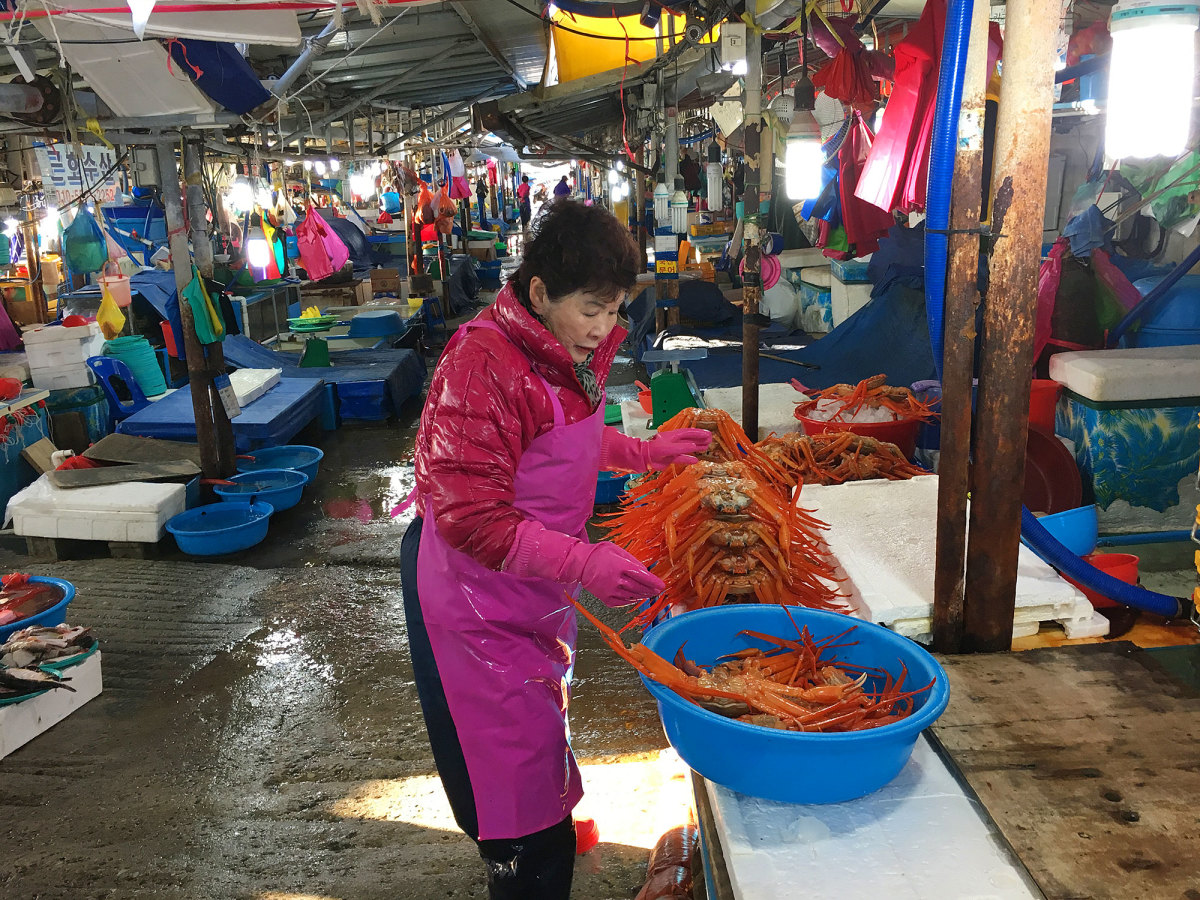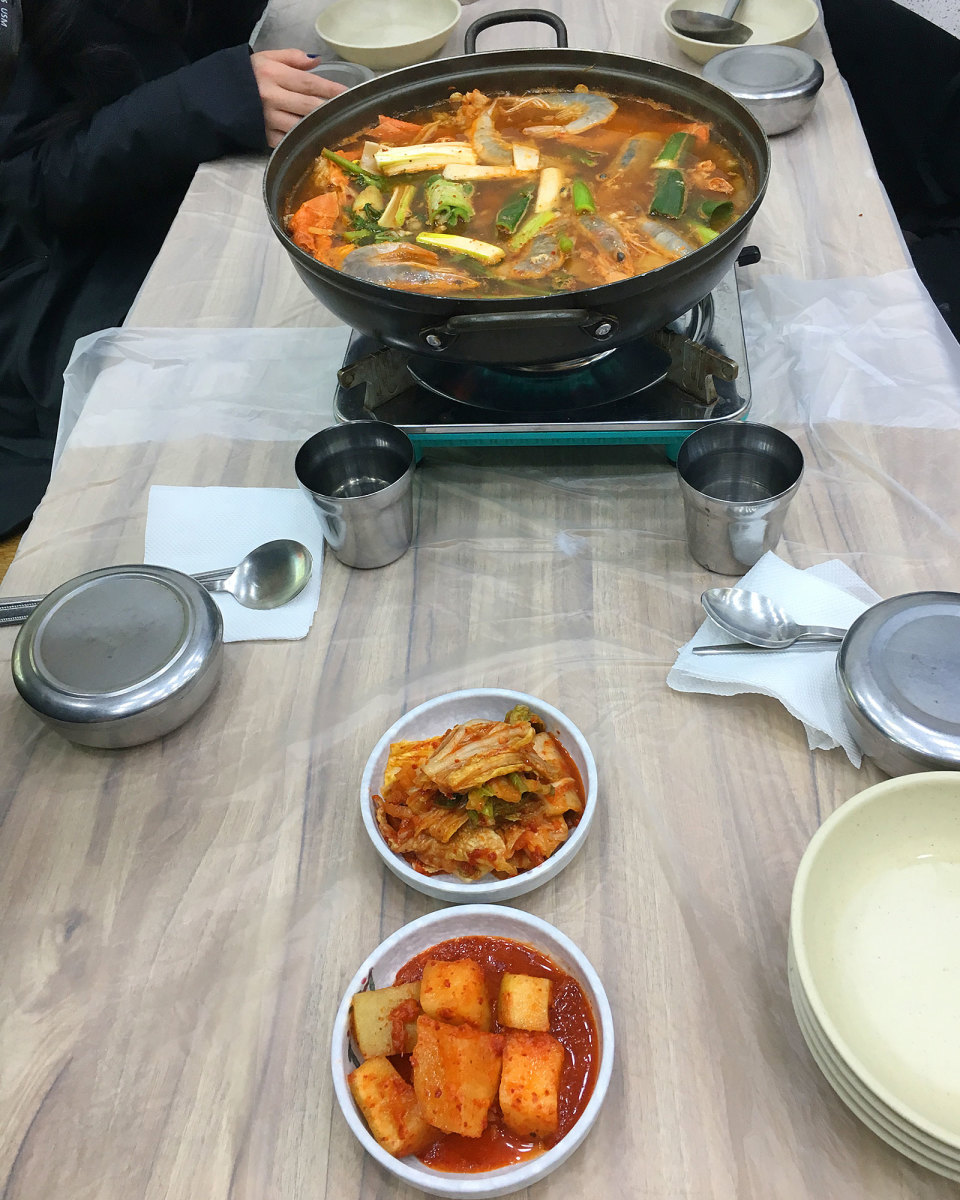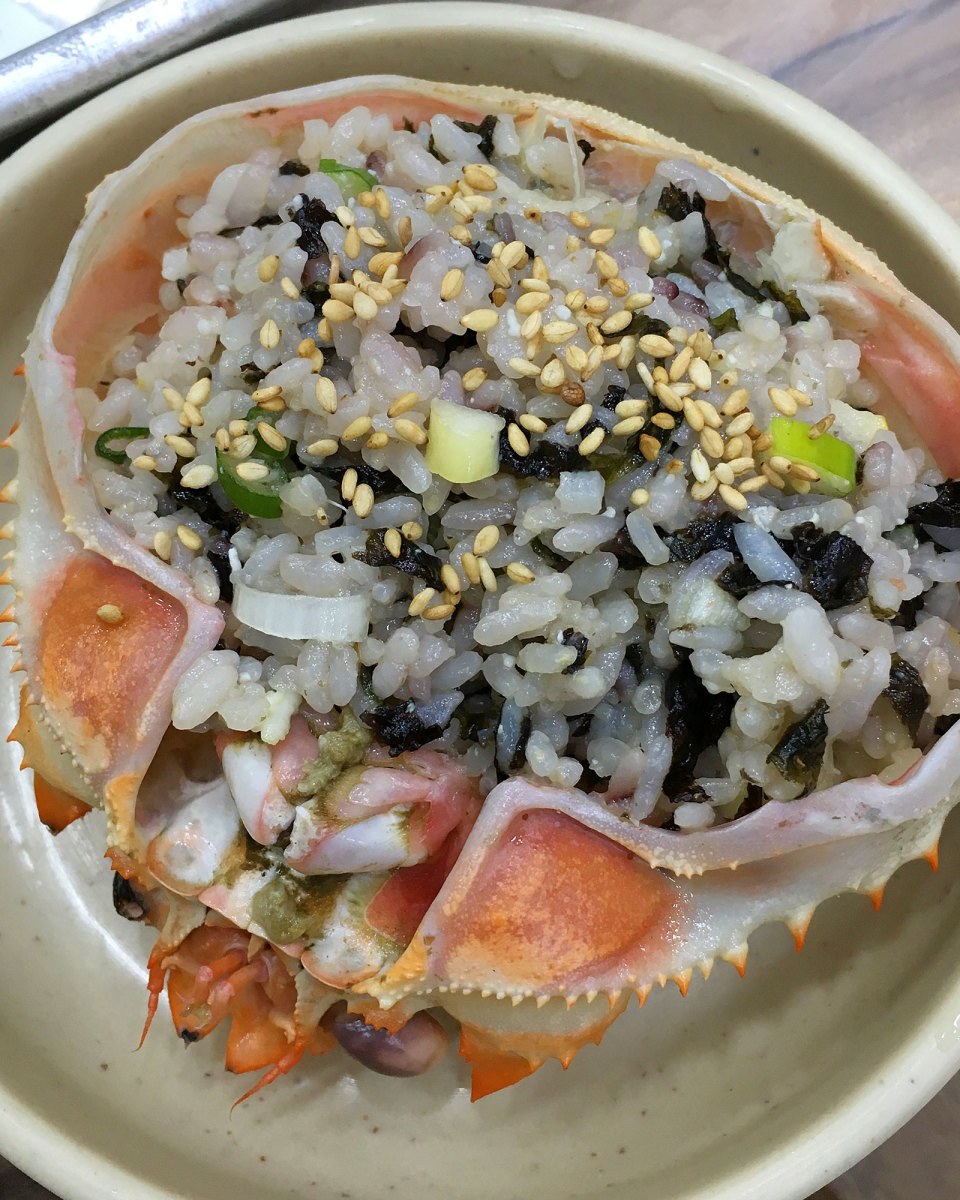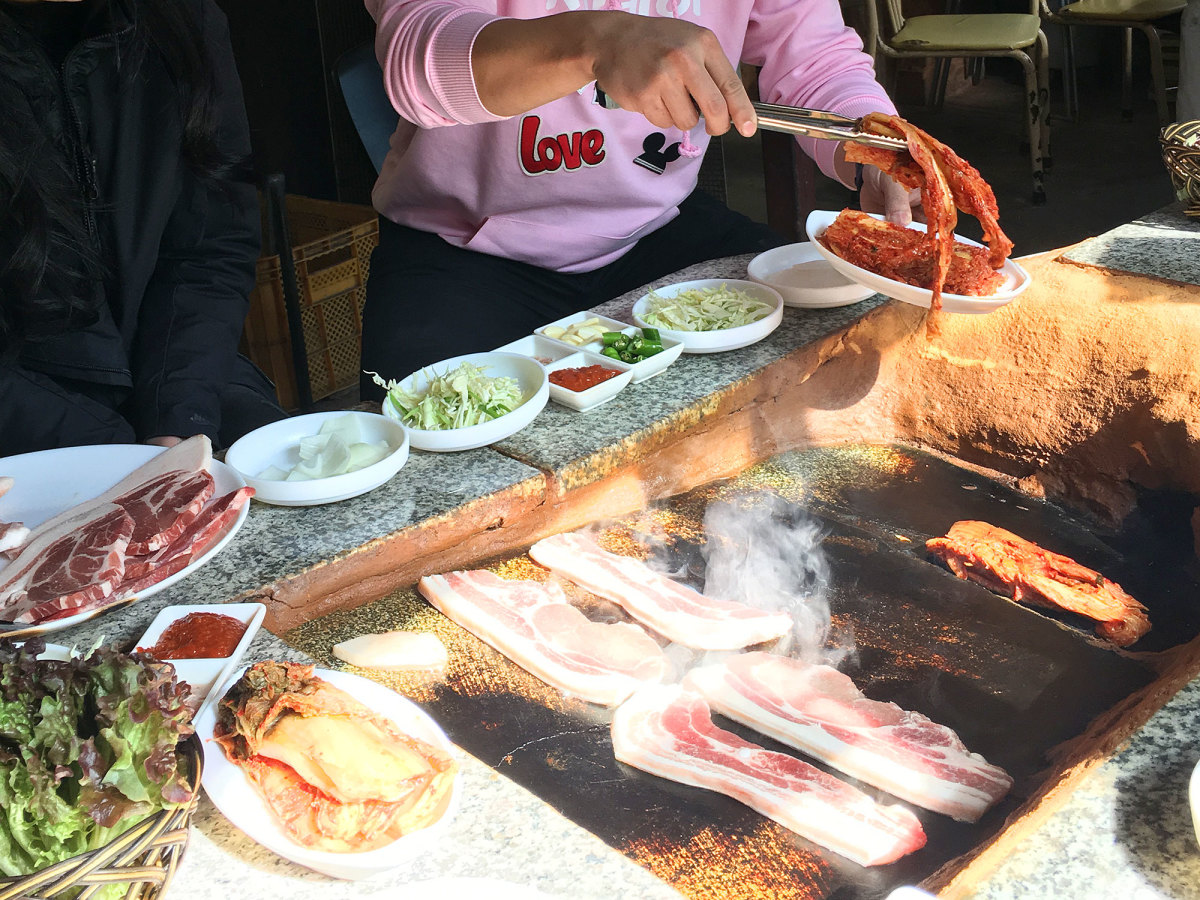Squid Ink Ice Cream! Jeju Black Pig! One Gluttonous Day Exploring Local Cuisine Outside PyeongChang

The crab had been dead for only three hours and the kimchi had been stewing for three years. Those ingredients—and their opposite extremes in prep time—were two highlights in one glorious, gluttonous day outside of PyeongChang, South Korea.
Sports are all well and good, but it would not be a trip to the Olympics without taking in some of the local culture. With help from Deuki Hong, a Korean-American chef at the Sunday Bird restaurants in San Francisco, and Monica Lee, a PyeongChang food enthusiast, SI Eats went in search of the best grub in the nearby city of Gangneung.
The bell starts ringing shortly after 7 on a frigid morning by the water. A man in tall rubber boots slips the bell into his back-right pocket and starts talking into a headset microphone. Behind him, men haul wheelbarrows full of fish away from the docked boats and toward the sea of buckets. The plastic containers fill quickly with a varied menu: There are round, plump globefish that look like mini basketballs; long, slender fish; wide, flat fish; 8-kilogram cod, 10 of which fill a bucket the size of your bathtub. Plus there’s crab and squid and sea squirt, too.
The Jumunjin Fish Market is the largest seafood market on Korea’s east coast. The East Sea separates Korea from Japan, and the finest catches make landfall here. But if you want the top-shelf best of the daily catch, you better get there close to daybreak.
The man in the boots is an auctioneer. Bidders surround him, frantically writing on tickets, and hoping to get theirs placed right on top of the water-filled buckets, with the fish still flopping around below. Winning bidders carry their trove back to their restaurants, or their stalls at the expansive market a block away.
The market is a sight to behold. Aisle after aisle of crabs stacked atop each other like totem poles, tables with fish sprawled across every inch, cutting boards where women with machetes skin poisonous blowfish and slice out the meat.

Our troupe makes out with a decent deal: 10 red snow crabs, which we’re told are perfectly in-season, for 30,000 won. That comes out to a little over $28 for 10 giant crabs that had been swimming earlier that morning. They even throw in a handful of free shrimp to sweeten the deal.
After negotiating the purchase, there are a few options for transport. Some customers carry their food home and others get it shipped, but we elect for option number three. Our seller carries our bag of crabs and walks with us across a street and around the corner to a small restaurant called Bukcheong Haejanguk (Deuki and Monica’s best transliteration of the Korean sign). For a prepping fee, the cooks there will let us walk in with our own ingredients and walk out stuffed like the blowfish.
The restaurant is relatively small, with fewer than a dozen tables. But the tables are on a raised and heated platform, long enough to accommodate large groups ready for family style sharing. We remove our shoes, ascend the platform and sit cross-legged or kneeling at the table. We sit down at place settings with scissors, plastic gloves, individual rice dishes and a variety of sides including chili peppers and raw fermented squid. (A little spicy and better than it sounds!) Three different crab dishes will soon hit our table. It’s barely 9 a.m.
Dish No. 1 is a spicy crab stew. Our waiter sets a burner down on the table so we can watch it simmer in front of us—the crab legs, the shrimp, some veggies like bean sprouts and onions, all sprinkled with a dusting of Korean chili pepper powder. It is spicy and perfect; it’s the only warming needed on a day when temperatures outside feel like the single digits. I want to curl up with it on my couch for movie night instead of hot chocolate. They should serve it to the cross-country skiers as they cross the finish line.

Dish No. 2 is a simple recipe: Just the crab. No other frills or tricks. When we arrived, the restaurant cooks dropped our crab into a steamer and that was all it took. Deuki tells us about how important the water quality is to the taste of the seafood that comes out of it. Because the East Sea is so perfect, and the crab is so fresh, it doesn’t need any seasoning. It’s salty, but not too salty, and can stand on its own without needing to be dipped in butter or cocktail sauce. You can just eat long pieces of the meaty crab legs on their own.
Dish No. 3 is the grand finale, served last. Bibimbap is a traditional Korean rice dish, usually mixed with some combination of a meat, veggies and sesame oil. I’ve had it several times already this week, but not like this. We cut the crab legs off with scissors and used our gloved hands to pry open the main torso of the crab. Inside we found all the guts and juice that crab-lovers are probably familiar with. Our servers took the shells from us, crab juices and all, to use as a serving dish for the bibimbap. The crab shells returned, with a mixture of rice, crab juices, sesame oil and seaweed. So, basically a crab-infused rice. Good as served, or topped off with some of the leftover crab stew.

Three courses, a group of extremely satisfied guests and a professional chef who is impressed.
It’s time for a walk. As we wind through the market, we come across a storefront that specializes in squid. They take their squid seriously at the Jumunjin market, with a giant statue of one not far from where we saw the auction. So we decide to go for a palate cleanser—squid ink ice cream. You can watch the video for more details, but here’s all I can say: The squid ink flavor of ice cream tasted like salted caramel, and I know you might be skeptical, but you just have to believe me.
It’s time to get out of the market before we eat any more. We have lunch reservations less than four hours after our breakfast feast, and we can’t afford to keep snacking.
If you ask me to point out our lunch spot on a map, I won’t be able to find it. If you try to look on Google or Instagram, it won’t turn up. Monica, who has been living in the PyeongChang region for a few months now, is our ticket in. She says that locals don’t even know about it. But she somehow came across the Yonggol Persimmon Tree House, and it’s now the place she delights in taking out-of-town visitors. This is not a hole in the wall; it’s a needle in a haystack.
Jeju Island is on the map, about 60 miles south of the Korean mainland. It’s a small island known for its beach resorts and volcanoes. Deuki says it’s like Korea’s Hawaii. The island is also known for Jeju Black pig—an animal whose meat Deuki tells us you can’t get in the United States. Jeju Black pig is also literally the only dish on the Persimmon Tree House menu.
The restaurant is one small building within a larger compound, and the owner/chef/waitress is extremely hospitable as we arrive. She has broken out her finest ingredients. Either she is really happy Monica keeps bringing back guests, or she is showing off for our cameras. Maybe both. Not complaining either way.
There are no tables per se inside of our cramped building. Instead, we will sit around the grill. What makes Persimmon Tree House stand out from other Korean barbecue joints is that the grill is built into a clay furnace. We’re told that this is how homes used to be heated in the old days, with clay furnaces below certain floors. The metal grill top is built into it, and tilted down at an angle so that the food grilling at the top can send juices running down onto whatever dish is cooking toward the bottom. There is a hole in the bottom of the grill for the fat and juices to drain out. Deuki asks where it leads to and we’re basically told, “It goes where it goes.”
The first step in this feast is to remove our jackets. The temperatures outside have us bundled up, but the entire room is about to get warm in a hurry. That’s not the only reason to remove layers—anyone who eats at the Persimmon Tree House is guaranteed to smell like meat for the rest of the day. We’re given plastic bags big enough to contain our winter coats but all of our other layers will smell like a barbecue pit.
Out comes the Jeju pig. It is sliced into wide flat slivers of pork belly. The skin was left on and it turns crispy around the edges as it cooks. Along with the meat, we’ve got several side items: lettuce wraps, pickled radishes, onions, sliced chili peppers and whole cloves of garlic. We also have chung guk jang, a smelly stew. If you get past the smell, the ingredients have a better taste. The main veggie is gondeurae, a thistle that Monica tells us was once relied on heavily in Korea during a rice shortage.
But there’s one more item we need. It wouldn’t be Korean barbecue without some kimchi—the traditional staple of pickled and fermented veggies. Of course it’s made in-house here, and apparently stored for long periods of time. We are presented with two options: A kimchi that was pickled in the fall, and a kimchi that has been aged for three years. Known as muk eun ji when it ages that long, the kimchi is so fermented that we’re advised to grill it instead of eating it raw. We put it all the way at the bottom of the grill and let the fat from the pork belly run all over it. We sample both batches like kimchi sommeliers: “Ah yes, this tastes like a 2015.”

Deuki mans the grill, cutting the pork belly into strips using the same type of scissors we’d gotten for the crabs at breakfast. We try different combinations in the lettuce wraps and resort to things like eating the grilled, fat-slathered garlic gloves whole.
Every time we think we’re done, more food shows up. The pork belly is excellent, and then our hostess arrives with a second cut of meat from the Jeju—the jowl. It’s tougher and fattier, but also delicious. For dessert she brings us some rice, mixed with sesame oil, seaweed and a homemade kimchi paste. It’s like a kimchi fried rice, or basically our second dessert bibimbap of the day. We mix it together right in the center of the grill, the part with the most pork belly fat.
The Olympic Games are so massive, and so close by, but they are the farthest thing from anybody’s mind. In a tiny room where the heat from the clay furnace grill fogs up the windows and a meat smoke lingers below the ceiling, we have taken in a day of traditional food different from the westernized or mass-produced meals that will be eaten by many of the incoming tourists. Elsewhere around Gangneung, life goes on as usual for the fishermen, the market salespeople, the chefs and restaurateurs. It’s an incredible food culture and we have sampled some of the best.
